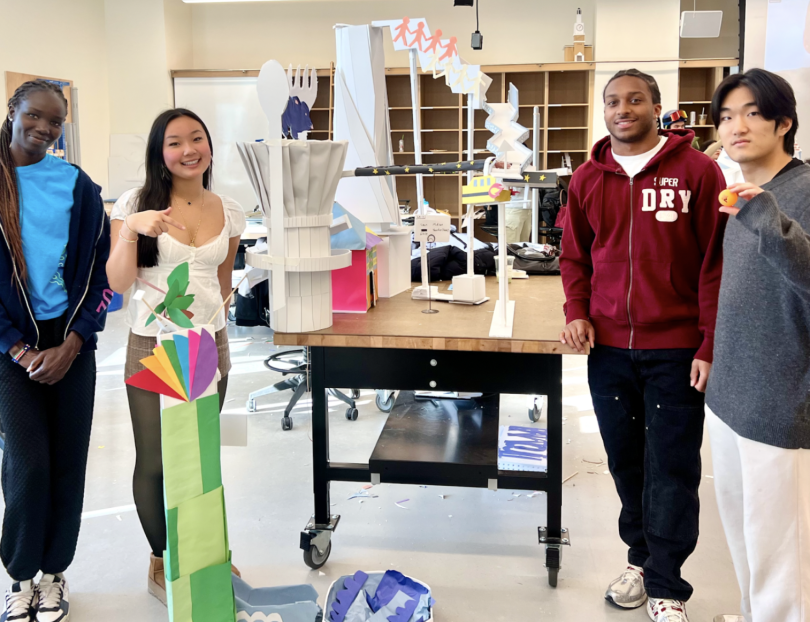

Madison Wuu


Takeaways from Engs12: Design Thinking
If there's one class at Dartmouth that's always in high demand, it's ENGS 12: Design Thinking—and for good reason. I took it this winter, and what stood out to me about the class was how it emphasizes hands-on learning and collaborative problem-solving over traditional lectures and exams. It also satisfies the Technology or Applied Science distributive requirement, which is a nice bonus.
Each class begins with a "Stoke"—a fun, energizing activity designed to boost morale and get us in the right mindset. One memorable "Stoke" we did was a rock-paper-scissors tournament. We started by playing with a partner, and if we lost, we became our partner's biggest cheerleader. The cheering grew louder with each round until the final showdown. Another "Stoke" had us meditate for five minutes, focusing on our breath and tuning into the natural rhythms of our bodies. Whether it's a high-energy competition or a moment of mindfulness, "Stokes" are a fun and engaging way to start class.
The course is heavily project-based, with students working in teams to identify human needs through in-depth interviews and research. We then brainstorm ideas, prototype, test, and refine our designs based on feedback, iterate on improvements, assemble our final product, and present our solution to the class. In the teams I've worked with, we often start meetings with a "Stoke" or use them as a quick reset whenever we feel our energy levels dipping.

Beyond the classroom, TA-led sessions give us a chance to pick up practical skills like sewing, video editing, and using software like Adobe After Effects. I've found attending these sessions really helpful, whether I need guidance on a project or just want to learn something new. I've found that learning different skills and creative techniques makes it easier to bring ideas to life in the projects I undertake and adds to the hands-on, collaborative spirit of the course.
Takeaway #1: Design Thinking has shown me how powerful visual cues can be in communicating ideas to teammates. I've never been very confident in my drawing skills, but I've come to realize that everyone possesses some level of artistic ability. It's not about being the best artist—rough sketches can still help others visualize your ideas.
The same goes for building quick, low-fidelity prototypes to test designs. Designers don't wait until they have all the answers; they build their way forward, focusing on the next steps rather than the final product.
A great place to start when tackling a problem is with empathy. Understanding people's needs shapes how we define problems, brainstorm ideas, and create prototypes that explore uncharted territories. Prototyping itself is a problem-solving tool—it helps clean up the mess of complex issues through visual design and allows for rapid iteration to refine ideas. The more versions you create, the better because each iteration brings new insights.
Prototyping also helps designers reframe challenges, test new perspectives, and uncover solutions that may have seemed impossible. Through iteration, ideas evolve, and each version reveals something new. By making both explicit and implicit relationships visible, designers can connect ideas in ways that might not be immediately obvious. And having something visual—whether a sketch, a model, or an interactive demo—makes sharing and developing ideas so much easier.

Takeaway #2: Another important lesson I've learned is not to get too attached to an idea. People naturally want to solve problems quickly, but rushing to a solution can mean overlooking better options. We should be willing to sit with the issue and embrace the discomfort that comes with it. Roadblocks are part of the process—trial and error is how you figure out what truly works. Even if an idea seems excellent, sometimes it's not practical, and letting it go can open the door to a better solution.
Takeaway #3: Design Thinking has taught me the importance of giving and receiving constructive feedback. Professor Rafe introduced us to the "I Like, I Wish, I Wonder" framework as a helpful way to structure input. He also emphasized three key forms of feedback: appreciation, coaching, and evaluation. Appreciation acknowledges effort and motivates by making people feel seen and valued. Coaching helps expand knowledge, sharpen skills, and improve overall capacity. Evaluation measures work against a set of standards, providing clarity on where something stands.
While critiques can sometimes feel harsh, they are essential for growth. Feedback is a gift that helps us improve and reach our goals more effectively. Designers should always remain open to constructive input, as there is always room to refine and enhance ideas. A culture of honest, thoughtful feedback—where people are both kind and direct—fosters stronger collaboration and leads to more creative, impactful work.
Takeaway #4: The last takeaway I'll share is that everyone approaches problem-solving differently. Some focus on the positives, others on risk management, and some rely on intuition or emotion. Each perspective adds value. Marinating in the data with my teammates, I've found it helpful to share interviews, map out common themes, and explore different viewpoints while working on group projects. These diverse perspectives are what drive innovation!
Posts You Might Like

My experience in my first ever literature class!


All about Writing 5 (and my favorite watches from the course materials!)


During my sophomore spring quarter, I took on the challenge of four STEM courses, and while it has been intense, the unexpected connections across subjects and the joy of learning have made it one of my most rewarding academic experiences yet.


Hello finals week! As I close out a finals season, dive into my bag to see just what gets me through this time of the term!


On the Beijing LSA+, we have real-world Chinese practice every Friday. Last week we went to two neighborhoods, Houhai and Shichahai, and wrote a photo log about our experience. Read along to see what immersive language learning here looks like!


Curious about what a class looks like on a Dartmouth Foreign Study program? Read on!


With so many undergraduates hoping to participate in the exceptional atmosphere of the Tuck School of Business, Tuck created programs specifically designed for us. I was fortunate enough to take part in one of them: TuckLAB Entrepreneurship.



For the past few weeks I've been in Beijing on the Chinese Language LSA+. Follow along to see what I'm up to!

